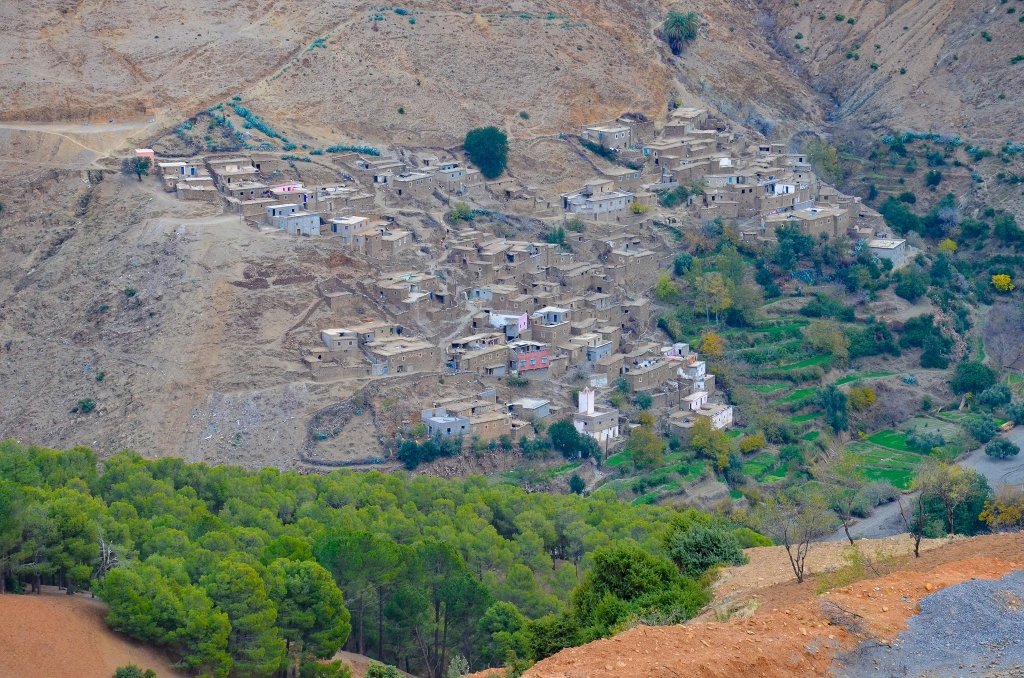Imagine a village where time moves to the rhythm of seasons, not clocks. Where terraced apple orchards cling to mountainsides, and a blush-pink mosque glows under the Atlas sun. This is Ait Irghite, a hidden Berber hamlet near Amizmiz that feels like stepping into a living postcard. If you’re craving a Morocco untouched by mass tourism—where every smile, spice, and stone tells a story—this is your destination. Let’s wander through its cobbled paths and discover why Ait Irghite is the soul of the Atlas Mountains.
Why Ait Irghite? Authenticity Unfiltered
Tucked into the foothills near Amizmiz, Ait Irghite is a masterclass in Berber resilience. With just a few hundred residents, this village isn’t on most tourist maps—and that’s its magic. Here, life revolves around terraced gardens, communal irrigation systems, and generations-old traditions. Visiting isn’t just a trip; it’s an invitation to witness Morocco’s unvarnished beauty.
A Day in Ait Irghite: Sights, Smells, and Stories
1. The Village Landscape: A Symphony of Stone and Soil
Ait Irghite’s charm lies in its simplicity:
- Mud-Brick Homes: Built from earth and stone, these structures blend seamlessly into the mountains.
- The Pink Mosque: A standout with its warm rose hue, reflecting the village’s quiet spirituality.
- Terraced Gardens: Walnut groves, apple orchards, and vegetable plots (tomatoes, squash, oranges) cascade down slopes—a testament to Berber agricultural ingenuity.
Don’t miss the 1-kilometer irrigation channel carved into the mountain. It ends in a series of small waterfalls and pools, a lifeline for the village and a serene spot to linger.
2. Homestays: Sleep Like a Local

Forget hotels—here, you’ll bunk in a family’s living room. Expect:
- Warm Hospitality: Share mint tea and stories with your hosts.
- Home-Cooked Tajine: Dive into dishes slow-cooked over clay stoves (kanoun). Pro tip: Ask to watch the preparation—it’s an art form!
3. Berber Culture: Traditions Alive and Well
Ait Irghite’s residents have preserved their Amazigh language, crafts, and way of life for millennia. Spend time with locals to learn:
- Pottery and Weaving: Though not detailed in the source, nearby villages (like Amizmiz) offer workshops—ask your guide!
- Festivals: If visiting in spring, you might catch vibrant harvest celebrations.
Practical Tips for Visiting Ait Irghite
How to Get There
- From Marrakech: Take a local bus to Amizmiz (1 hour, ~$1). From there, hire a guide—roads to Ait Irghite are rugged and unmarked.
- Guided Tours: like Visit Amizmiz (highly recommended!) arrange transport, homestays, and cultural exchanges.
Best Time to Visit
- Spring (April–June): Orchards bloom, waterfalls gush, and temperatures are mild.
- Fall (September–November): Harvest season brings golden light and fresh produce.
What to Pack
- Layered Clothing: Mountain weather shifts quickly.
- Hiking Shoes: For rocky trails and terraced fields.
- Small Gifts: Pens for kids or spices for hosts show gratitude.
Cultural Etiquette
- Dress Modestly: Cover shoulders and knees, especially near the mosque.
- Ask Permission: Before photographing people or homes.
Why Ait Irghite Matters: Keeping Traditions Alive
In a world rushing toward modernity, Ait Irghite stands as a guardian of Berber heritage. By visiting, you’re not just a tourist—you’re supporting a community preserving its identity. As one traveler put it: “These mountain villages are the real face of Morocco.”
Have You Experienced Berber Village Life? Share Your Story!
Ait Irghite leaves an imprint on every traveler. Whether you’ve hiked its terraces, shared a tajine with locals, or marveled at the pink mosque, we’d love to hear your tales! Drop a comment below or tag us in your photos.
Planning a deeper dive? Pair your visit with an Amizmiz Valley excursion or a trip to Tinmel’s historic mosque. Morocco’s magic lies in its hidden corners—come find yours.




